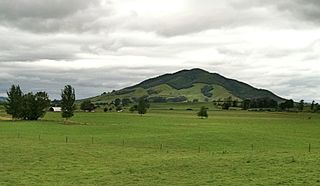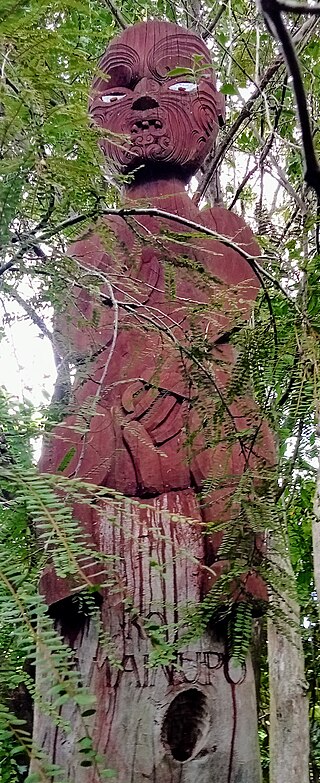
Mount Pirongia is an extinct stratovolcano located in the Waikato region of New Zealand's North Island. It rises to 959 m (3,146 ft) and is the highest peak around the Waikato plains. Pirongia's many peaks are basaltic cones created by successive volcanic eruptions between the late Pliocene and early Pleistocene, about 2.5 million years ago. In the adjacent picture, the characteristic profile of the mountain can be seen, along with a prominent accessory cone to the right.

Tainui was one of the great ocean-going canoes in which Polynesians migrated to New Zealand approximately 800 years ago. It was commanded by the chief Hoturoa, who had decided to leave Hawaiki because over-population had led to famine and warfare. The ship first reached New Zealand at Whangaparāoa in the Bay of Plenty and then skirted around the north coast of the North Island, finally landing at Kawhia in the western Waikato. The crew of the Tainui were the ancestors of the iwi that form the Tainui confederation.

Kakepuku is a volcanic cone which rises from the plain between the Waipā and Puniu rivers, about 3 km (2 mi) NW of Te Kawa and 8 km (5 mi) SW of Te Awamutu in the Waikato region of New Zealand's North Island.
Tāwhao was a Māori rangatira (chief) in the Tainui confederation of tribes, based at Kāwhia, New Zealand. He probably lived around 1500 CE. He was the last chief to lead the whole of Tainui, as the feud between his two sons Whatihua and Tūrongo led him to divide it into northern and southern sections.
Kinohaku was a Māori woman of the Ngāti Maniapoto tribe in New Zealand's Waikato region. She probably lived in the seventeenth century and is the eponymous ancestor of the Ngāti Kinohaku sub-tribe (hapū) of Ngāti Maniapoto.
Māhanga was a Māori rangatira (chieftain) of the Tainui tribal confederation in the Waikato region of New Zealand, based at Kāniwhaniwha on the Waipā River, and an ancestor of the Ngāti Māhanga and Ngāti Tamainupō hapu. Bruce Briggs estimates that he lived around 1600.
Pikiao was a Māori rangatira (chieftain) of the Te Arawa tribal confederation based at Lake Rotorua in the Bay of Plenty, New Zealand, who was the ancestor of Ngāti Pikiao in Te Arawa, of Ngāti Mahuta in the Tainui confederation, and of Ngāti Pāoa in the Marutūāhu confederation. He probably lived in the early seventeenth century.
Whatihua was a Māori rangatira (chief) in the Tainui confederation of tribes, based at Kāwhia, New Zealand. He quarrelled with his brother, Tūrongo, and as a result Tainui was split between them, with Whatihua receiving the northern Waikato region, including Kāwhia. He probably lived in the early sixteenth century.
According to Māori tradition, Hoturoa was the leader of the Tainui canoe, during the migration of the Māori people to New Zealand, around 1400. He is considered the founding ancestor of the Tainui confederation of tribes (iwi), who now inhabit the central North Island.
Tūrongo was a Māori rangatira (chief) in the Tainui confederation of tribes, based at Rangiātea, near Waikeria, New Zealand. He quarrelled with his brother, Whatihua, and as a result Tainui was split between them, with Tūrongo receiving the southern Waikato region. His marriage to Māhina-o-rangi created a genealogical link between Tainui and Ngāti Kahungunu of the East Coast, which is still commemorated. He probably lived in the early sixteenth century.
Tamāio was a Māori rangatira (chieftain) of the Tainui tribal confederation, based at Kāwhia in Waikato, New Zealand. He was the first chieftain to lead a war-party inland from Kāwhia, in a war against Ngāti Hā, sometime around the middle of the sixteenth century.
Hotunui was a Māori rangatira (chieftain) of the Tainui tribal confederation of Waikato, New Zealand. Through his son Marutūāhu he is the ancestor of four tribes of the Hauraki Gulf: Ngāti Maru, Ngāti Rongoū, Ngāti Tamaterā, and Ngāti Whanaunga. He probably lived in the latter half of the sixteenth century.

Kōkako was a Māori rangatira (chieftain) of the Tainui tribal confederation in the Waikato region of New Zealand. He probably lived in the late sixteenth century.

Tamainu-pō was a Māori rangatira (chieftain) of the Tainui tribal confederation in the Waikato region of New Zealand and the ancestor of the Ngāti Tamainupō hapu. He probably lived around 1600.
Whāita was a Māori rangatira (chieftain) of the Ngāti Raukawa iwi in the Tainui tribal confederation based at Wharepuhanga near Rangitoto in the Waikato region, New Zealand and is the ancestor of the Ngāti Whāita hapū. He probably lived in the mid-seventeenth century.
Wairangi was a Māori rangatira (chieftain) of the Ngāti Takihiku hapu of the Ngāti Raukawa iwi in the Tainui tribal confederation from the Waikato region, New Zealand and the ancestor of the Ngāti Wairangi hapū. He probably lived in the mid-seventeenth century.
Kaihamu was a Māori rangatira (chieftain) of the Tainui tribal confederation from the Waikato region, New Zealand. He probably lived in the first half of the seventeenth century.
Rakataura, also known as Hape or Rakatāura, is a legendary Polynesian navigator and a progenitor of many Māori iwi. Born in Hawaiki, Rakataura was the senior tohunga (priest/navigator) who led the Tainui migratory canoe to New Zealand. Rakataura is associated with stories involving the Manukau Harbour, the Te Tō Waka and the Waikato. Many place names in Tāmaki Makaurau and the Waikato region reference Rakataura, or are described in oral traditions as being named by Rakataura.
Te Ata-inutai was a Māori rangatira (chieftain) of the Ngāti Raukawa iwi in the Tainui tribal confederation based at Whare-puhunga in the Waikato region of New Zealand. He led an attack against Ngāti Tūwharetoa on the south shore of Lake Taupō, as a result of disputes arising from the Ngāti Tama–Ngāti Tūwharetoa War and forged a peace treaty with the Tūwharetoa chieftain Te Rangi-ita, but was ultimately murdered in his old age by members of Tūwharetoa in vengeance for his earlier attack. He probably lived in the early seventeenth century.
Pare-kāwa was a Māori rangatira (chieftain) of Ngāti Tūwharetoa from the region around Lake Taupō, New Zealand. She is the ancestor of the Ngāti Parekāwa hapū. She probably lived in the mid-seventeenth century.






